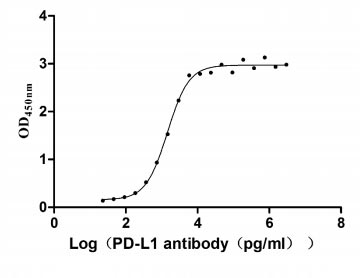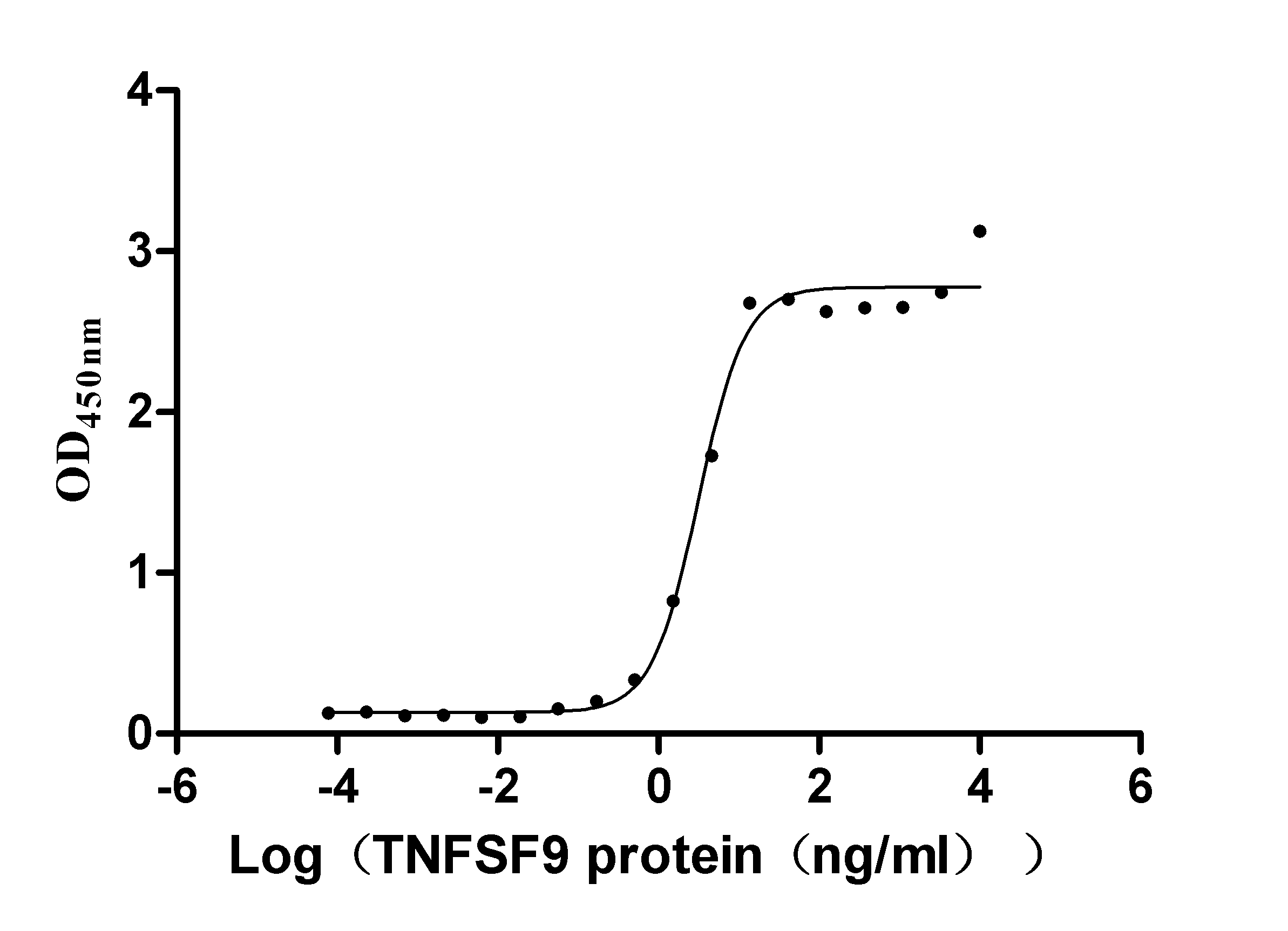Recombinant Human Beclin 1-associated autophagy-related key regulator (ATG14)
-
货号:CSB-YP741052HU
-
规格:
-
来源:Yeast
-
其他:
-
货号:CSB-EP741052HU-B
-
规格:
-
来源:E.coli
-
共轭:Avi-tag Biotinylated
E. coli biotin ligase (BirA) is highly specific in covalently attaching biotin to the 15 amino acid AviTag peptide. This recombinant protein was biotinylated in vivo by AviTag-BirA technology, which method is BriA catalyzes amide linkage between the biotin and the specific lysine of the AviTag.
-
其他:
-
货号:CSB-BP741052HU
-
规格:
-
来源:Baculovirus
-
其他:
-
货号:CSB-MP741052HU
-
规格:
-
来源:Mammalian cell
-
其他:
产品详情
-
纯度:>85% (SDS-PAGE)
-
基因名:
-
Uniprot No.:
-
别名:4832427M01; ATG14; Atg14L; Autophagy-related protein 14-like protein; BAKOR_HUMAN; Barkor; Beclin 1-associated autophagy-related key regulator; D14Ertd114e; D14Ertd436e; KIAA0831; mCG_6911
-
种属:Homo sapiens (Human)
-
蛋白长度:full length protein
-
表达区域:1-492
-
氨基酸序列MASPSGKGAR ALEAPGCGPR PLARDLVDSV DDAEGLYVAV ERCPLCNTTR RRLTCAKCVQ SGDFVYFDGR DRERFIDKKE RLSRLKSKQE EFQKEVLKAM EGKWITDQLR WKIMSCKMRI EQLKQTICKG NEEMEKNSEG LLKTKEKNQK LYSRAQRHQE KKEKIQRHNR KLGDLVEKKT IDLRSHYERL ANLRRSHILE LTSVIFPIEE VKTGVRDPAD VSSESDSAMT SSTVSKLAEA RRTTYLSGRW VCDDHNGDTS ISITGPWISL PNNGDYSAYY SWVEEKKTTQ GPDMEQSNPA YTISAALCYA TQLVNILSHI LDVNLPKKLC NSEFCGENLS KQKFTRAVKK LNANILYLCF SQHVNLDQLQ PLHTLRNLMY LVSPSSEHLG RSGPFEVRAD LEESMEFVDP GVAGESDESG DERVSDEETD LGTDWENLPS PRFCDIPSQS VEVSQSQSTQ ASPPIASSSA GGMISSAAAS VTSWFKAYTG HR
-
蛋白标签:Tag type will be determined during the manufacturing process.
The tag type will be determined during production process. If you have specified tag type, please tell us and we will develop the specified tag preferentially. -
产品提供形式:Lyophilized powder
Note: We will preferentially ship the format that we have in stock, however, if you have any special requirement for the format, please remark your requirement when placing the order, we will prepare according to your demand. -
复溶:We recommend that this vial be briefly centrifuged prior to opening to bring the contents to the bottom. Please reconstitute protein in deionized sterile water to a concentration of 0.1-1.0 mg/mL.We recommend to add 5-50% of glycerol (final concentration) and aliquot for long-term storage at -20℃/-80℃. Our default final concentration of glycerol is 50%. Customers could use it as reference.
-
储存条件:Store at -20°C/-80°C upon receipt, aliquoting is necessary for mutiple use. Avoid repeated freeze-thaw cycles.
-
保质期:The shelf life is related to many factors, storage state, buffer ingredients, storage temperature and the stability of the protein itself.
Generally, the shelf life of liquid form is 6 months at -20°C/-80°C. The shelf life of lyophilized form is 12 months at -20°C/-80°C. -
货期:Delivery time may differ from different purchasing way or location, please kindly consult your local distributors for specific delivery time.Note: All of our proteins are default shipped with normal blue ice packs, if you request to ship with dry ice, please communicate with us in advance and extra fees will be charged.
-
注意事项:Repeated freezing and thawing is not recommended. Store working aliquots at 4°C for up to one week.
-
Datasheet :Please contact us to get it.
相关产品
靶点详情
-
功能:Required for both basal and inducible autophagy. Determines the localization of the autophagy-specific PI3-kinase complex PI3KC3-C1. Plays a role in autophagosome formation and MAP1LC3/LC3 conjugation to phosphatidylethanolamine. Promotes BECN1 translocation from the trans-Golgi network to autophagosomes. Enhances PIK3C3 activity in a BECN1-dependent manner. Essential for the autophagy-dependent phosphorylation of BECN1. Stimulates the phosphorylation of BECN1, but suppresses the phosphorylation PIK3C3 by AMPK. Binds to STX17-SNAP29 binary t-SNARE complex on autophagosomes and primes it for VAMP8 interaction to promote autophagosome-endolysosome fusion. Modulates the hepatic lipid metabolism.
-
基因功能参考文献:
- Knockdown of ATG14 protein leds to decreased autophagy and chemoresistance of melphalan-resistant myeloma cells PMID: 30121664
- This study identifies an unexpected role for PtdIns(4,5)P2 signaling in the regulation of ATG14 complex and autophagy. PMID: 27621469
- These data provide evidence for additional roles of Atg2A and Atg14L in the formation of early autophagosomal membranes and also in lipid metabolism. PMID: 24776541
- we found that ATG14 interacted with Ulk1 and LC3, and knock down of Ulk1 prevented the lipidation of LC3 and autophagy in HeLa-ATG14 cells. We also identified a phosphatidylethanolamine (PE) binding region in ATG14, and the addition of Ulk1 to Hela-ATG14 cells decreased the ATG14-PE interaction. PMID: 28069524
- polar BECN2 CCD interface residues result in a metastable homodimer, facilitating dissociation, but enable better interactions with polar ATG14 residues stabilizing the BECN2:ATG14 heterodimer. PMID: 28218432
- use circular dichroism and small-angle X-ray scattering (SAXS) to show that the ATG14 coiled-coil domain (CCD) is significantly disordered but becomes more helical in the BECN1:ATG14 heterodimer, although it is less well-folded than the BECN1 CCD homodimer PMID: 27383850
- These results define a key molecular event for the starvation-induced activation of the ATG14-containing PtdIns3K complex by ULK1. PMID: 27046250
- data suggest an autophagy-specific membrane fusion mechanism in which oligomeric ATG14 directly binds to STX17-SNAP29 binary t-SNARE complex on autophagosomes and primes it for VAMP8 interaction to promote autophagosome-endolysosome fusion PMID: 25686604
- Cisplatin upregulated Barkor protein levels of the Saos-2 cell line. PMID: 24337183
- Atg14 is critical in controlling an autophagy-dependent phosphorylation of beclin-1. We map novel phosphorylation sites to serines 90 and 93 and demonstrate that phosphorylation at these sites is necessary for maximal autophagy. PMID: 23878393
- Our findings reveal that Atg14L, previously considered to be solely a Beclin 1-binding autophagy protein, plays a novel role in the late stage of endocytic trafficking in conjunction with Snapin PMID: 22797916
- Anaplasma actively induces autophagy by secreting Ats-1 that hijacks the Beclin 1-Atg14L autophagy initiation pathway likely to acquire host nutrients for its growth PMID: 23197835
- Atg14 is a new target gene of FoxOs and the core clock machinery, and this gene plays an important role in hepatic lipid metabolism PMID: 22992773
- analysis of how the Beclin1 coiled-coil domain interface regulates homodimer and heterodimer formation with Atg14L and UVRAG PMID: 22314358
- Data suggest that the Atg14L-dependent appearance of phosphatidylinositol 3-phosphate in the endoplasmic reticulum makes this organelle the platform for autophagosome formation. PMID: 20713597
- These results suggest that mammalian cells have at least two distinct class III PI3-kinase complexes, and that beclin 1 interacts distinctly with mammalian Atg14 and UVRAG in two of these complexes. PMID: 18843052
- study defines a regulatory signaling pathway mediated by Barkor (KIAA0831) that positively controls autophagy through Beclin 1 PMID: 19050071
- Two Beclin 1 associated proteins, Atg14L and Rubicon, were identified. PMID: 19270696
- Barkor/KIAA0831 functions as an autophagy targeting factor for Beclin 1 and the class III PI3 kinase. Barkor and UVRAG form two distinct protein complexes with the core class III PI3 kinase. Barkor is a functional ortholog of yeast Atg14. PMID: 19050071
显示更多
收起更多
-
亚细胞定位:Cytoplasm. Endoplasmic reticulum membrane; Peripheral membrane protein. Preautophagosomal structure membrane; Peripheral membrane protein. Cytoplasmic vesicle, autophagosome membrane; Peripheral membrane protein.
-
蛋白家族:ATG14 family
-
数据库链接:
HGNC: 19962
OMIM: 613515
KEGG: hsa:22863
STRING: 9606.ENSP00000247178
UniGene: Hs.414809
Most popular with customers
-
Recombinant Human Programmed cell death 1 ligand 1 (CD274), partial (Active)
Express system: Mammalian cell
Species: Homo sapiens (Human)
-
Recombinant Human Tumor necrosis factor ligand superfamily member 9 (TNFSF9), partial (Active)
Express system: Mammalian cell
Species: Homo sapiens (Human)
-
Recombinant Human IGF-like family receptor 1 (IGFLR1), partial (Active)
Express system: Mammalian cell
Species: Homo sapiens (Human)
-
Recombinant Human Angiopoietin-2 (ANGPT2) (Active)
Express system: Mammalian cell
Species: Homo sapiens (Human)
-
Recombinant Human Intestinal-type alkaline phosphatase (ALPI) (Active)
Express system: Mammalian cell
Species: Homo sapiens (Human)
-
Recombinant Human Claudin-4 (CLDN4)-VLPs (Active)
Express system: Mammalian cell
Species: Homo sapiens (Human)
-
Recombinant Mouse Cell adhesion molecule 1 (Cadm1), partial (Active)
Express system: Mammalian cell
Species: Mus musculus (Mouse)
-
Recombinant Human C-type lectin domain family 4 member C (CLEC4C), partial (Active)
Express system: Mammalian cell
Species: Homo sapiens (Human)





-AC1.jpg)














